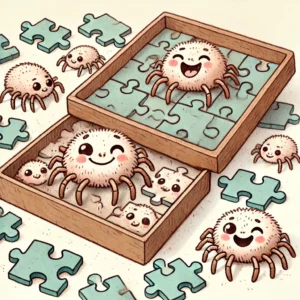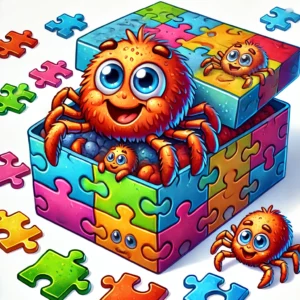If you are looking where to buy used jigsaw puzzles cheaply (without puzzle mites), you are not alone. The new jigsaw puzzle options are becoming more expensive and with the impending tariffs, it looks like you will need to fork over even more cash.
Here is our quick list of where to buy used jigsaw puzzles cheaply:
- Ebay
- Facebook Marketplace
- Local Garage Sales and Swapmeets
- Amazon (look for used jigsaw puzzles)
- Puzzle Groups (ask about yearly sales or private sales)
- Library Puzzle Swaps
There are several options for purchasing used jigsaw puzzles, both online and in-person. We encourage you to save as much money as you can while still enjoying the puzzles. These quick tips are perfect when searching for your next jigsaw puzzle to buy.
6 Quick Tips for buying used puzzles:
- Look at the box: Watch for damaged pieces or signs of wear that could indicate damage.
- Shake the box hard: The pieces are loose, but if there is something else in there you might feel it rattle around
- Watch for bagged Puzzles: Puzzles with pieces bagged inside the box are more likely to be complete when buying used. Also people might share on the bag if a piece is missing..
- Check the brand: Name brands have higher quality and are more likely to be in better condition.
- Know if there are missing pieces: Is the puzzle’s complete? Definitely ask when buying, especially when buying online.
- What are the shipping costs: Shipping for online purchases can be expensive. Know how much it will cost when comparing jigsaw puzzle prices.

Buying used puzzles? How about buying used jigsaw puzzles? Before you lay down your cash, you need to be paying close attention to what you might find inside the puzzle boxes. Plus you need to make sure everything is inside (that’s supposed to be included.)
Puzzle Mites? Or Bed Bugs? No Thanks
Don’t get me wrong, I’ve had some awesome puzzling experiences with thrift store jigsaw puzzles, but then there was the puzzle insects (puzzle mites) episode. Which was the worst of the worst. Also, I’ve encountered bent pieces and missing pieces with purchases too. It’s all about taking the time to look at the puzzle.
Table of Contents
Buying used jigsaw puzzles can be a fantastic way to save money, discover rare puzzles, and reduce waste. However, not all secondhand puzzles are created equal. Some may be incomplete, damaged, or have hidden issues that can ruin the puzzling experience. Before making a purchase and getting excited about the next speed puzzling session, here’s what to watch out for and how to deal with common problems like smoky smells, puzzle dust, and even puzzle lice.
1. Missing Pieces: The Biggest Dealbreaker
The most frustrating issue with used puzzles is missing pieces. Some sellers will mark their puzzles as “complete,” but others may sell them “as-is” without knowing whether all the pieces are there. Here’s how to reduce the risk of buying an incomplete puzzle:
- Look for completed puzzle photos: If the seller has assembled the puzzle and provides a picture, it’s a good sign.
- Check reviews: If buying from an online marketplace, read reviews to see if previous buyers report missing pieces.
- Count the pieces (if possible): If you’re at a thrift store or garage sale, open the box and see if the pieces look complete.
- Buy from reputable resellers: Some used puzzle sellers specialize in secondhand puzzles and verify completeness before selling.
If you do end up with a missing piece, you can contact the puzzle manufacturer. Some companies offer replacement pieces, though this is more common for newer puzzles.
2. Smoky or Heavily Perfumed Puzzles: Dealing with Unpleasant Odors
Used puzzles often come from homes with strong odors, whether from cigarette smoke, musty storage, or heavy perfumes. This can make puzzling unpleasant, especially if you’re sensitive to smells.
How to remove unwanted smells:
- Air it out: Spread the pieces out on a clean, dry surface and let them sit for a few days.
- Baking soda trick: Place the pieces in a sealed container with an open box of baking soda to absorb odors.
- Dryer sheets: Sealing the puzzle in a bag with dryer sheets can help neutralize smells.
- Vinegar wipe: Lightly wipe the puzzle pieces with a cloth dampened with a vinegar-water solution, then let them dry completely.
If the odor is overwhelming and persistent, it might be best to pass on the puzzle.
3. Puzzle Mites: A Common Gross Problem
Where did the jigsaw puzzle come from? Puzzle mites and bedbugs can be found in some used puzzles (especially from damp storage areas). The boxes tend to harbor tiny pests, sometimes referred to as a general term “puzzle lice.” While there is a debate on what this exactly is, there is no doubt these don’t belong in the puzzle box and can get out into your home. These aren’t actual lice but can be tiny insects or mites that live in cardboard. Puzzle mites? Lice? Bed bugs? Whatever you call it, I have dealt with an infestation that arrived at my house in a used puzzle box and it’s not pretty.
Signs of Puzzle Lice (also called Puzzle Mites):
- Tiny moving specks in the box
- Dust-like residue that moves when disturbed
- Musty or moldy smell
How to deal with puzzle lice
- Freeze the puzzle: Place it in a sealed bag and put it in the freezer for 48–72 hours. This kills any pests.
- Inspect before purchase: If the box looks old and has been stored in a damp area, check inside for any signs of infestation.
- Avoid puzzles stored in basements or garages: These environments are more likely to encourage pests.
4. Puzzle Dust: A Messy Nuisance
Puzzle dust is the fine cardboard residue left behind after pieces are cut. It’s common in lower-quality puzzles or heavily used ones.
How to reduce puzzle dust:
- Shake the pieces out before bringing them inside.
- Use a colander or mesh sieve to separate the dust from the pieces.
- Wipe the pieces with a dry cloth before assembling.
5. Thin Piece Jigsaw Puzzles: A Flimsy Frustration
Some used puzzles, especially budget brands, may have thin, low-quality pieces that don’t hold together well.
How to spot thin pieces before buying:
- Check the brand: Trusted brands tend to have sturdy pieces.
- Look for thickness: If the pieces appear flimsy, they may not interlock well.
- Ask about the material: Avoid puzzles made from thin, cheap cardboard.
6. Bent Pieces: An Annoying Fit Problem
Bent or warped pieces can make assembling the puzzle difficult and cause false fits.
How to check for bent pieces:
- Examine edge pieces. If they’re curling, the puzzle may not lay flat.
- Check storage conditions. Humidity and poor storage can lead to warped pieces.
- Press them flat. Some slightly bent pieces can be flattened by placing them under a heavy book for a few days.

7. False Fits: The Wrong Piece in the Right Spot
False fits occur when pieces seem to fit together but don’t actually belong. This is more common in puzzles with imprecise cuts or repeated shapes.
How to avoid false fits:
- Choose puzzles with unique cuts. Higher-quality brands often have more distinct piece shapes.
- Look for grid vs. random cuts. Random-cut puzzles have more variation, reducing false fits.
- Double-check the image. If a piece doesn’t quite match the design, it’s likely a false fit.
8. Dog Hair, People Hair and Hair Balls Stuck to stuff
When I think about all the hair I’ve seen in used jigsaw puzzle boxes, I tend to barf in my mouth. It’s disgusting. I don’t know who decides one day to drop a few dozen strands in the box before handing it over to a thrift store. Yet, it happens and I can’t deal with it personally. I find this more offensive than a missing piece….especially human hair.
Final Thoughts: How to Pick a Good Used Puzzle
- To make sure you’re getting a great puzzle experience, follow these tips:
- Buy from reputable sellers who check for missing pieces.
- Inspect the box for damage, odors, or signs of pests.
- Choose well-known brands for better quality.
- Look at the puzzle image is it something you’ll enjoy?
- Check the piece thickness and material before buying.
Second Hand Puzzles Anywhere Can be Problematic
Shopping for used puzzles can be a great way to find unique designs and save money, but it pays to be cautious. You would be surprised at how many puzzles are dropped off at swaps and offered at those boxes that have serious issues. Throwing away second hand puzzles is tough, but if you are careful you can definitely have a positive experience. Pay attention and have a knowing what to watch out for, so you can avoid frustration and ensure an enjoyable puzzling experience.
